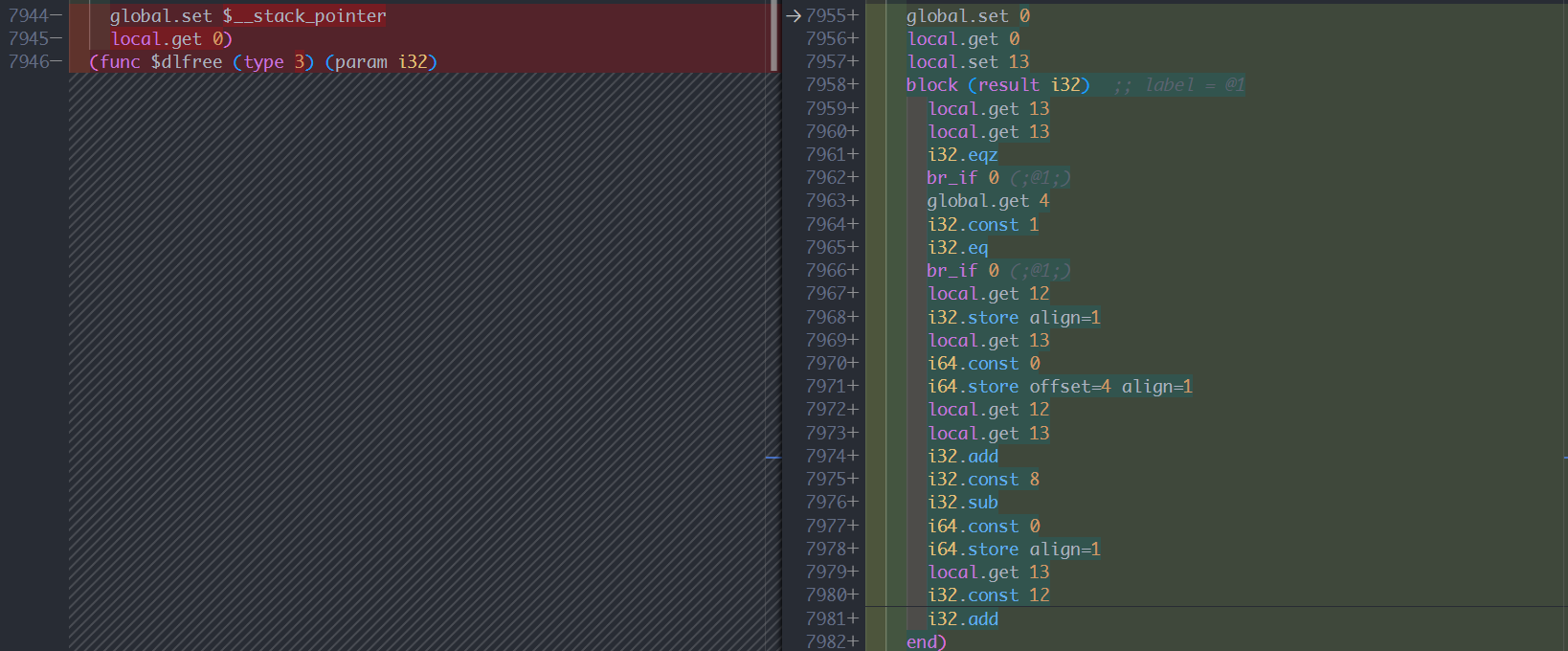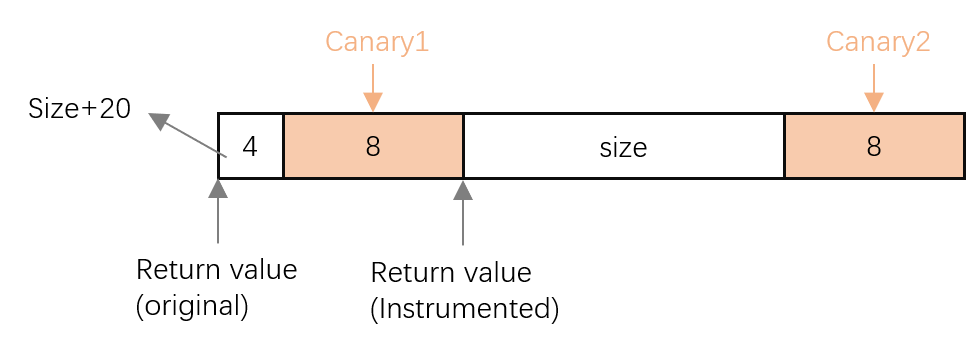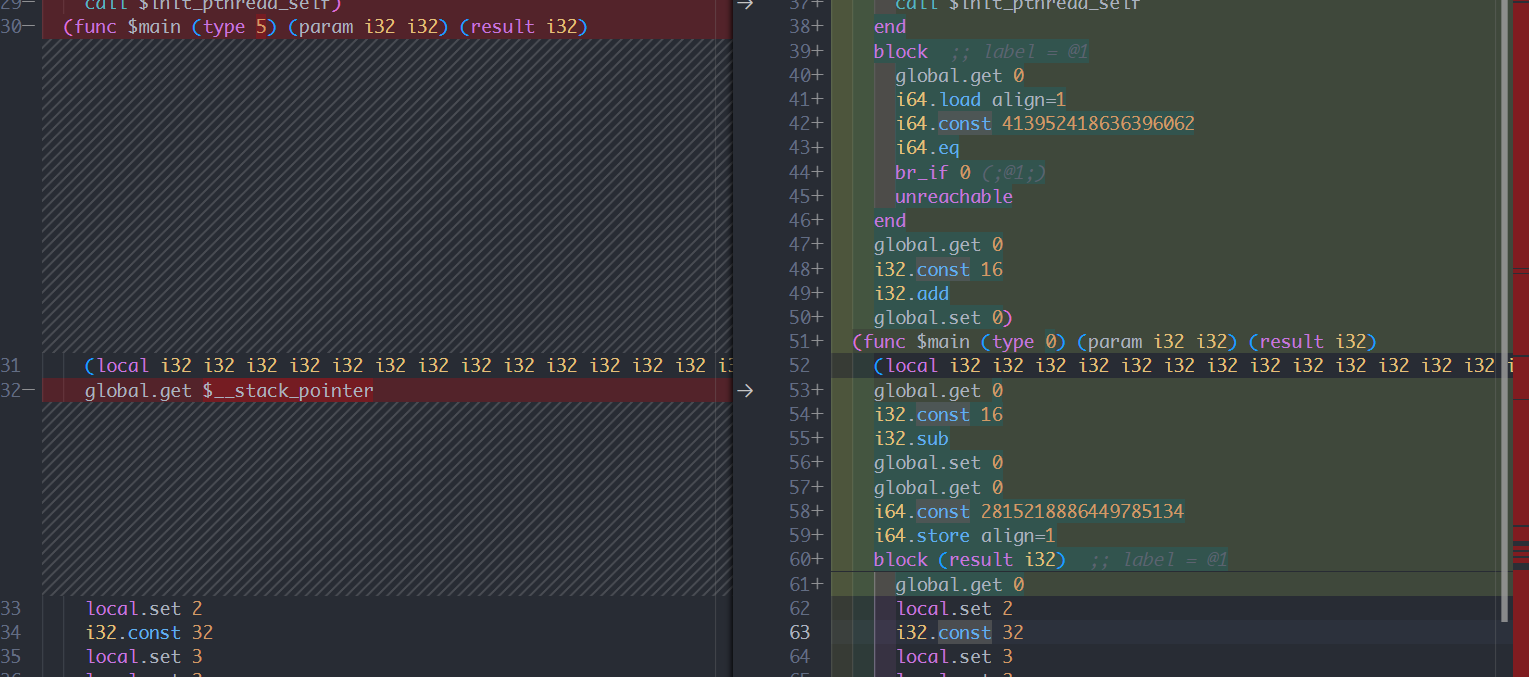Fuzzm Heap&Stack Instrumentation代码解析
1. instrument_with_heap_canary_check()
Source: /fuzzm-project/wasm_instrumenter/src/canaries.rs
Functionality: 对Wasm插入heap canary
1. dlmalloc(size)
1.1 Prefix

- 插入内容:
block
global.get $__disable_canary_insertion_in_malloc
i32.const 1
i32.eq
br_if 0
local.get 0
i32.const 20
i32.add
local.tee 12
local.set 0
end- **插入位置:**dlmalloc函数代码段开头。
- 解析:
block
global.get $__disable_canary_insertion_in_malloc
i32.const 1
i32.eq
br_if 0
;;...
end这里在dlmalloc函数开头插入一个新的block,编号为block 0。Wasm中的br/br_if指令的功能是跳出目标block,故这里前几句的功能是判断$__disable_canary_insertion_in_malloc是否等予1,如果等于则直接跳过该块的插桩代码。
$__disable_canary_insertion_in_malloc 在实际的Wasm指令中一般是最后一个globe的值。
block
;;...
br_if 0
local.get 0
i32.const 20
i32.add
local.tee 12
local.set 0
end这里字面上的逻辑是将local 0的值加了20,并将这个值也存在local 12(最后一个local)中。在Wasm中函数的参数是存在局部变量中的,这里dlmalloc接受一个size参数用于表示需要分配的内存大小,故这里实际上是让dlmalloc分配size+20空间的内存,多出的20用于存储canary。
1.2 Postfix

在原本函数结尾:
global.set $__stack_pointer
local.get 0这两句指令重新设置了栈帧,并将返回值(local 0)压栈。
插桩后的代码在这两句指令之后加入了如下指令:
local.set 13
block (result i32)
local.get 13
local.get 13
i32.eqz
br_if 0
global.get $__disable_canary_insertion_in_malloc
i32.const 1
i32.eq
br_if 0
local.get 12
i32.store align=1
local.get 13
i64.const 0
i64.store offset=4 align=1
local.get 12
local.get 13
i32.add
i32.const 8
i32.sub
i64.const 0
i64.store align=1
local.get 13
i32.const 12
i32.add
end首先,其使用local.set 13将栈上的返回值存储到了local 13中,然后在函数结尾插入了一个block。
在block中,首先进行了两次条件判断:
block (result i32)
local.get 13
local.get 13
i32.eqz
br_if 0
global.get $__disable_canary_insertion_in_malloc
i32.const 1
i32.eq
br_if 0
;;...
enddlmalloc的返回值是已分配空间的首地址,这判断dlmalloc是否返回零(分配失败)并判断是否需要跳过canary,接着:
block
;;...
local.get 12
i32.store align=1
local.get 13
i64.const 0
i64.store offset=4 align=1
;;...
end第一句local.get 12之后当前的栈:

故接下来i32.store align=1将size+20存储到了分配好的空间的开头4字节,类似地,i64.store offset=4 align=1将0(i64,8字节)存储到了分配好的空间的第5-12个字节处,这里的0就是canary。
接下来:
block
//...
local.get 12
local.get 13
i32.add
i32.const 8
i32.sub
i64.const 0
i64.store align=1
local.get 13
i32.const 12
i32.add
end这段代码将0(i64,8字节)存储到了已分配好的空间的倒数第=八个字节,并使函数返回已分配好的空间的首地址+12的地址。

2. dlfree(p)
free函数会在free操作之前检查canary的值。
2.1 Prefix

br判断的流程与上述相似,这里略(总的来说就是跳过$__disable_canary_insertion_in_malloc和返回值为Null的情况)。
检查第一个canary:
block ;; label = @3
local.get 0
i32.const 12
i32.sub
local.set 0 ;; 将指针指向return - 12,即dlmalloc原本分配的位置
local.get 0
i32.const 4
i32.add
i64.load align=1 // load canary 1
i64.eqz ;; 检查是否为0
br_if 0 (;@3;)
unreachable ;; 如果不为零则报错:"RuntimeError: unreachable"
end检查第二个canary:
block ;; label = @3
local.get 0
i32.load align=1 ;; size+20入栈
local.get 0
i32.add
i32.const 8
i32.sub
i64.load align=1 // load canary 2
i64.eqz ;; 检查是否为0
br_if 0 (;@3;)
unreachable ;; 如果不为零则报错:"RuntimeError: unreachable"
end以上就是heap canary在fuzzm中的具体实现,作者在这里使用了简单的两个64位的0来作为canary。
- 如果有目的的构造溢出,这个canary可以被绕过(canary的部分覆盖为0即可);
- 开头的4字节(size+20)如果被修改?
- 这个措施增加了多少性能损耗?
- 这个canary要求每个dlmalloc都对应一个dlfree,但在真实的代码中并不一定所有dlmalloc都会被主动释放。(可以学习rust的做法,每个函数或scope退出后主动添加free吗?)
2. instrument_with_heap_canary_check()
Source: /fuzzm-project/wasm_instrumenter/src/canaries.rs
Functionality: 对Wasm插入stack canary
2.1 哪些函数需要插桩?
fn requires_canary_check(f: &Function, stack_ptr: &Idx<Global>) -> bool {
// emscripten adds the stackAlloc and stackRestore functions
// that both break the invarint that the stack size prior to function
// entrance is equal to the stack size after function exit.
// The stackAlloc function is used to, for example, allocate space for argv
// before the main function is called.
let breaks_stack_invariant = is_stack_alloc(f, stack_ptr) || is_stack_restore(f, stack_ptr);
// we check instr_count > 1 since all functions implicitly have an end instruction.
f.instr_count() > 1 && !breaks_stack_invariant
// possible other optimizations?
// TODO check if f even uses the stack pointer.
}Emscripten添加的stackAlloc和stackRestore函数并不遵循栈平衡原则,故作者排除了这两个函数或者指令数小于等于1的函数。
2.2 Prefix

对函数开头的插桩如下:
(func func_name (type 0) (param i32 i32) (result i32)
global.get $__stack_pointer
i32.const 16
i32.sub
global.set $__stack_pointer ;; 函数栈帧增长16字节
global.get $__stack_pointer
i64.const $__random_number
i64.store align=1 ;; 在栈帧边缘插入8字节随机数
block (result i32) ;; 将原本函数体包裹
;; func_body
br 0
end
)2.3 Postfix
对函数结尾插桩如下:
(func func_name (type 0) (param i32 i32) (result i32)
;;...
block
global.get $__stack_pointer
i64.load align=1
i64.const $__random_number
i64.eq ;; 比较栈帧边缘的值和随机数是否相等
br_if 0
unreachable ;; 如果不相等则报错:"RuntimeError: unreachable"
end
global.get $__stack_pointer
i32.const 16
i32.add
global.set 0 ;; 将栈帧复原
)Reference
- Blogs:
- Github:
